When it comes to setting up an affiliate program, building up an affiliate commission structure is the cornerstone.
Setting an effective commission rate may be a bit vague for affilaite marketing newcomers. You may just, um, set up a 10% commission rate like your competitors did!?
Well, commission rates could be more complicated than this. Our article will introduce you a systematic approach to building a proper commission structure for your affiliate program. Here are 8 steps:
- Understand compensation models and commission structure
- Research commission benchmarks of your niche
- Budget for affiliate commission
- Default commission
- Advance commission
- Affiliate Incentives
- Commission conditions
- Review and optimize commission structure
Let’s dive in!
#1 Understand the basics of compensation models and commission structure
Compensation models and commission structures are different. Compensation models are the mechanisms by which an affiliate can earn cash, and a commission structure can be the combination of various compensation models.
The Compensation model refers to the approach used to determine how affiliates earn commissions. Below are the main types of compensation models commonly used in eCommerce:
- Percent of sale: Affiliates earn a percentage of the sales amount made via affiliate links.
- Flat rate per item: Affiliates earn a fixed amount for an item referral. Each item may enjoy a different commission rate.
- Flat rate per order: Affiliates earn a fixed amount for each referral, regardless of the sale amount.
The 03 models above are variants of commission over purchases (or pay-per-sale). Some more complicated models, such as pay-per-action, rev-share… are often used in more specific cases.
The commission structure, on the other hand, details the specific rates, tiers, bonuses, and other factors that tell how much commission affiliates receive based on their performance. Here are the most common commission structures:
- Commission tiers: Affiliates enjoy a higher commission rate whenever they reach a new performance milestone.
- Recurring commission: Affiliates earn for any purchases made by a customer since their affiliate link first clicked. Typically, orders are commissionable within a preset timeframe.
A commission structure may only compounded by only 01 model, but can also be a combination of various compensation models. For example, you can set up percentage commissions for normal products and flat-rate items for product A.
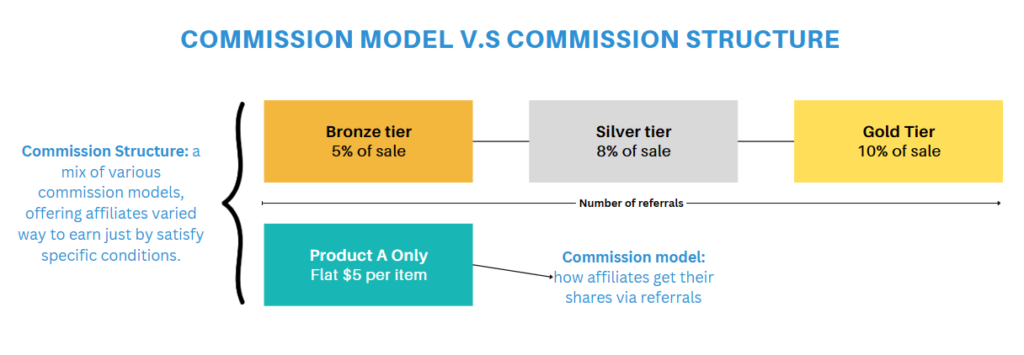
A good understanding of compensation models and how to combine them is the precondition to setting an effective commission structure.
#2 Research commission benchmarks of your niche
In many cases, people set unrealistic commission rates for their affiliate programs. It’s due to a lack of understanding of industry benchmarks.
Check out the industry benchmark
To explore industry benchmarks, you can start with Google. But do not just stop there. A shallow research will show you only general information. We suggest digging deeper competition analysis (reading industry reports, for example) to get better insights.
Here are some foundational questions you need to answer after conducting your research:
- What are the most popular commission rates and commission structures in your industry?
- Who are the most competitive players in the industry? Are there any of your product lines competing directly with theirs?
- What is your competitive advantage, compared to other competitors?
Typically, the proper commission rate is your competitive advantage to get suitable attract affiliates. In other words, your rates should be higher than industrial giants and your competitors.
Sure, here’s a table summarizing affiliate commission benchmarks across various industries:
| Industry | Commission Range |
| E-commerce/Retail | 1% – 20% |
| Technology | $10 – $200 or 1% – 75% |
| Finance/Insurance | $10 – $200 or 1% – 50% |
| Travel/Hospitality | $1 – $20 or 5% – 15% |
| Health/Fitness | $10 – $50 or 5% – 50% |
| Education | $10 – $50 or 20% – 75% |
| Automotive | $10 – $100 or 2% – 10% |
| Real Estate | $100 – $1000 or % |
| Food/Beverage | $10 – $50 or 5% – 15% |
Check out competitors’ commission
Sometimes, your niche is too specific so industry benchmarks do not reflect the true practice, competitors’ research is a better choice.
If you have created a well-established store, you might have a list of competitors already. Check out their affiliate program’s commission structure and identify what you can do better. Some common tactics to make your program more prominent are:
- Offer higher commission rates
- Offer more incentives (bonus, cash, affiliate rankings,…)
Of course, the mentioned above are only works if your brand and its competitors perform equally in terms of total quality over price.
But if you do not have any rival list in advance, here is a tip to spy on your competitors’s programs.
Inurl:”affiliate” intext:”powered by Shopify” intext:”your-product”
This means you are looking for a site that includes “affiliate” in the URL (which may indicate the existence of an affiliate program), created with Shopify, and selling the same product as yours.
Here is one example query: inurl:”affiliate” intext:”powered by Shopify” intext:”dog harness”
And here is the result on SERP:

Tip: You should not include too-specified products in your query because the affiliate program landing pages typically do not refer to too many products. In the case above, you can replace intext:”dog harness” to intext:”dog” to see more results.
#3 Calculate the available budget for the affiliate commission
Commission rate estimation is the most complicated stage while setting up an affiliate program. Many merchants simply skip this stage and, by trusting their guts or imitating competitors, set up a random commission rate.
The simplest way to identify an affiliate marketing budget is to calculate it based on price.
Product price = Production cost + overhead cost + reinvestment cost + budget for commission
So, with production cost is %20, reinvestment cost is %20 and overhead cost (ads, warehouse, salaries,…) is %40. Your affiliate marketing budget is 20%
Therefore, the commission rate, optimally, should be higher than that of competitors and of course lower than the total budget you have for affiliate marketing.
Total affiliate marketing budget = Default commission + other promotion
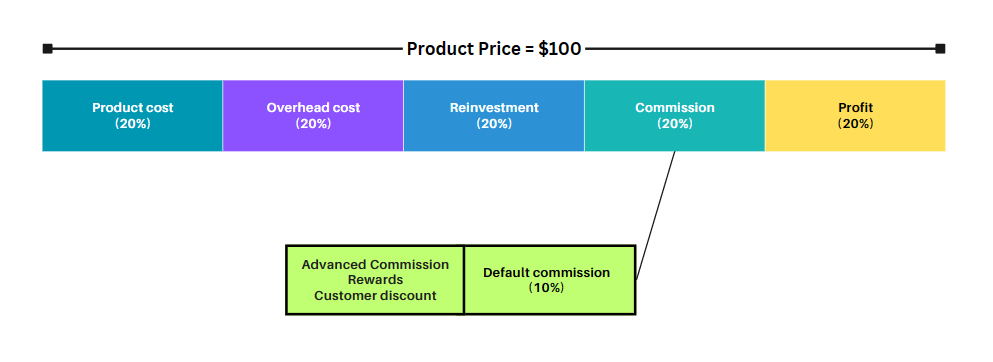
Affiliate marketing can capture up to 20% of product price, there are two examples:
- Offer affiliates a 10% commission that remains profitable and a planned 10% discount for first-time buyers.
- A tiered system: starting with a 4% commission for new affiliates, increasing to 8% after 20 sales, and reaching 12% after 50 sales. There is room to offer an 8% discount for customers in the promotion campaign.
For merchants starting out with affiliate marketing, we suggest applying a fixed commission rate with a customer discount, which makes your program manageable. Please note that while BixGrow affiliate links can be applied with auto-discount, we do not support discount badge designs (as in the image below) for a single product. There are other discount apps for customizable discount options.

Please note that the above is an extremely simplified version of commission calculation. An affiliate marketing budget can be much more complicated in realistic.
#4 Set up Default Commission
In affiliate marketing, “default commission” is the regular amount of money that affiliates earn for selling a merchant’s products or services. This rate is fixed, regardless of whether there are any extra bonuses for affiliates involved.
Typically, the default commission rate applies to all affiliates right after they join an affiliate program.

There are 03 types of default commissions:
- Percent of sale: A portion of the total sales amount from each order. For instance, if you designate a commission rate of 10% per sale, your affiliates will get 10% of the total sales value for every order they generate.
- Fixed amount per order: A fixed payment for each order, regardless of its value. For instance, if you establish a commission rate of $3 per order, your affiliates will earn $3 for each order they bring in, irrespective of the order’s total value.
- Fixed amount per item: A fixed payment for each item within an order. For example, if you set the commission rate at $3 per item, your affiliates will receive $6 for orders containing two items.
Default commission set-up simply is about choosing a compensation model and deciding how much to pay for the affiliate. It is totally okay to apply a simple affiliate commission structure which is made of only 01 compensation model.
#5 Advanced Commission
When it comes to advance commission, you need to have a deep understanding of the affiliate program.
Special products
Special Product Commission involves creating a different commission rate for specific products or groups of products (also called “collections”), or giving a commission solely for these products.
To configure the Special Product Commission, you need to click on the ‘Add product’ button.
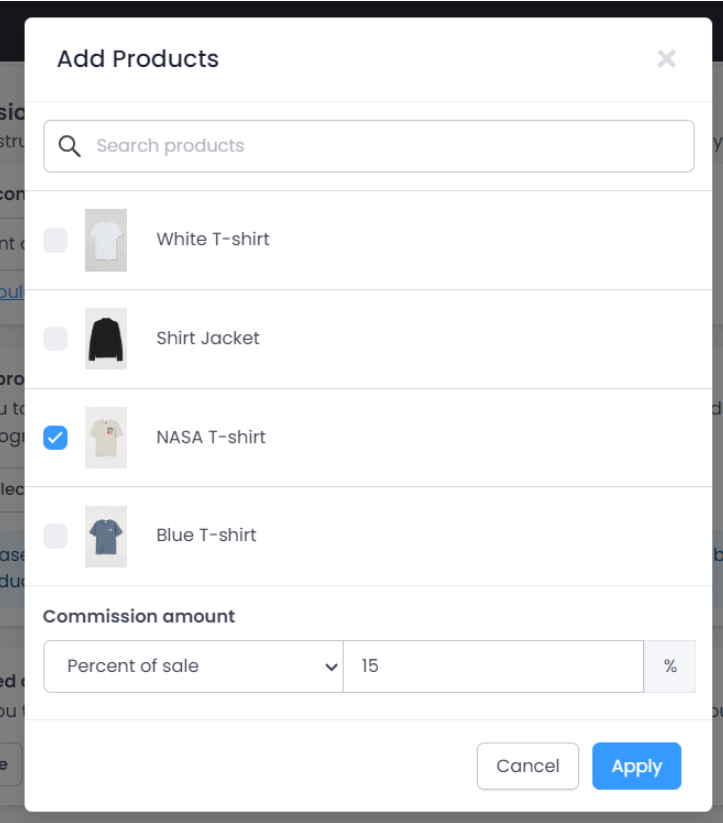
Here are some instances of combinations of Special Product Commission and Default Commission in the same order:
a. If your default commission type is Percentage of sale:
- Product A ($50) provides a 15% commission, and the default commission is set at 7%, so when a customer orders Product A and Product B ($150), the commission to be awarded will be: $50 x 15% + $150 x 7% = $22.50.
b. If your default commission type is a Fixed amount per order:
- Product A ($50) offers a 15% commission, and the default commission is $20 per order, so when a customer places an order for Product A and Product B, the commission to be given will be: $50 x 15% + $20 = $27.
Special Product Commission typically is able to add up with other commission types, but, you can totally turn off this function using BixGrow app using those edit buttons as follow.

Advanced commission rules
Advanced rules are prioritized in specific scenarios of commission calculation. This means that affiliate commissions are determined based on advanced rules rather than default rules.
Advanced commission structure rules are identified depending on factors such as Coupon, Customer, or Lifetime tracking.
- Specific coupon: A different commission will be applied for coupons assigned to certain affiliates, or customers, or inserted with words. Example use case: Default commission rate is 5% but orders using coupons that end with “NEWYEAR” will bring affiliates a 20% commission rate from 20/12 to 10/01
- Customer: The commission amount for orders placed by new customers will be X% and returning (old) customers will be Y%. Example use case: The commission rate is 10% for the first order and 5% for every subsequent order made by the same customer.
- Lifetime commission: The commission that affiliates receive for a customer’s subsequent orders will be X% as preset in Y months. Example use case: Commission rate is 10% for every order made by the same customer within 06 months since their last affiliate link click.
- Disable commission: Disables tracking and commission for affiliates/customers meeting specific conditions. Example use case: All purchases after the 5th order of a customer are non-commissionable.
If an order satisfies multiple conditions set up in the Advanced Commission Rule, only the rule with the highest priority will be implemented. You have the option to adjust their priority by reorganizing the rules.

Multi-level affiliates
Multi-level affiliate marketing is a model where affiliates earn commissions not only from their own sales but also from the sales generated by other affiliates they recruit into the program.

In this model, besides making money with default commission, affiliates can earn by cooperating and recruiting other new affiliates.
Here is how a multi-level commission structure works:
- Affiliates can recruit others to become affiliates under them, forming a downline or network.
- Affiliates earn commissions from both their direct sales and sales made by affiliates they recruited (downline).
- Commissions can be earned on multiple levels of the downline.
You can decide whether affiliates’ commissions are based on total sales or order value.
- Total sales: For example, affiliates earn $X if their downlines generate Y successful referrals.
- Order value: For example, affiliates earn a fixed $X (or Y% share) of purchase value generated by their downlines.
Launching a multi-level affiliate network is complex and can easily result in imbalance. Poorly designed structures may be seen as exploiting lower-level affiliates, as those at higher levels often profit more from the efforts of their recruits.
It’s crucial to avoid controversy by ensuring that early joiners don’t disproportionately benefit from affiliate commissions. Therefore, consider the following structure modifiers to keep your game balanced:
- Limit the number of downlines that are commissionable. For example, an affiliate can get rewards from two lower-level referrals. The opposite may lead to no unlimited potential of earnings for the affiliates at the top of the pyramid.
- Setting a minimum sales requirement for earning network commissions. For example, if you offer a $5 recruitment bonus and set a $30 minimum sales requirement, if Affiliate A recruits Affiliate B and B makes a sale, A won’t get a commission if B’s sales are below $30.
Additional options to modify your affiliate program:
- Additional options include giving bonuses to affiliates who recruit others successfully
- You can also assign new recruits to different programs if you don’t want them starting at the same level as their recruiter
Commission tiers
Commission tiers are different commission rates assigned to different affiliates depending on their sales performance.
In BixGrow, achieving a new commission tier is, essentially, moving to another affiliate program that offers higher commission rates.
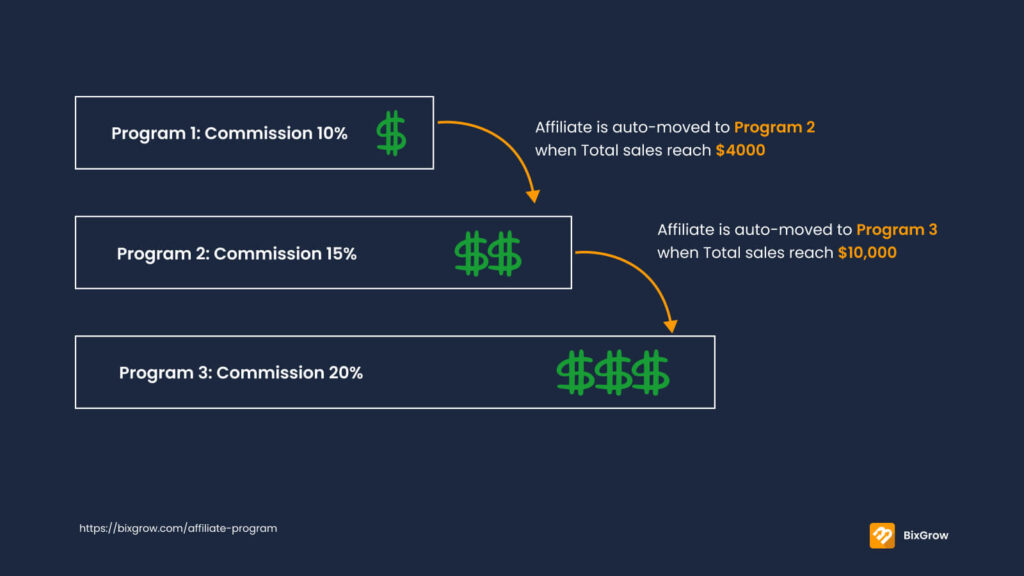
These tiers can be reset periodically to make sure all affiliates begin at the same tier after a timeframe.
#6 Set up Incentives for Affiliates
Incentives are usually determined by an affiliate’s performance, which is measured using various metrics like the number of referrals, leads generated, or revenue generated.
There are 03 cases of rewardings that can be applied overlapped.
- Rewards for successful recruits. Only applicable in multi-level affiliate marketing. Example: An affiliate might receive a $5 bonus for each successful recruit they bring into the network.
- Rewards for reaching sales performance. Example: If an affiliate exceeds $100 sales amount target, they receive a $10 cash bonus or a gift card.
- Rewards for reaching a new level of commission tier. Example: An affiliate get promoted to a higher commission tier, earn a $20 bonus and even enjoy a higher commission rate.
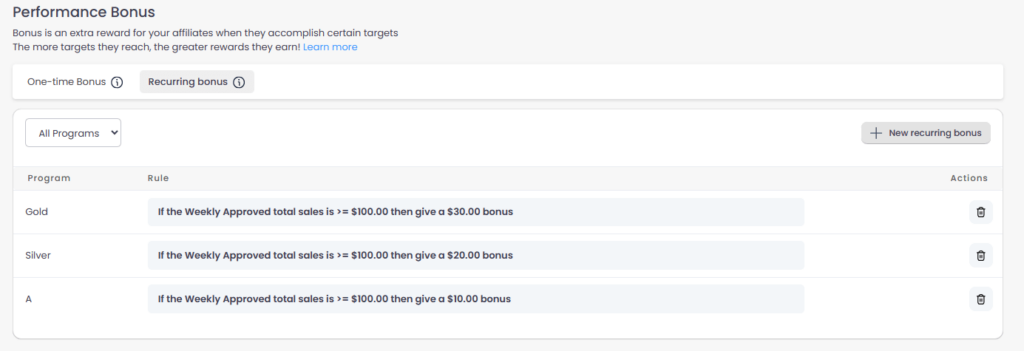
Typically, these incentives are added directly to the affiliate’s account as currency (e.g., dollars) or store credit (usable for in-store purchases). Alternatively, they may be exchanged for coupons, discounts, products, or physical gifts.
#7 Define other conditions for commissionable referrals
Cookie duration
Cookie duration is how long a referral is counted to an affiliate after their audience clicks on affiliate link. A longer cookie duration simply brings more chances for affiliates to get referrals, and affiliates love long cookie duration.
Cookie length is a part of commission structure as it will help affiliate define their potentials earning more specifically.
Cookie duration is typically set around 7 to 90 days.

Priority on trackings
There are two tracking methods available for calculating affiliate commissions: affiliate link and coupon. However, when a customer use both affiliate links and coupons to place orders, only one type will be applied.
Typically, when both are used, the order will be tracked by the coupon only as coupon are usually used for special promotional campaign, giving specific benefits.
Qualified referrals
There are conditions can be considered qualified as a successful referral.
Set asides structure’s standards such as product-based commission, customer-based commission or cookie windows, here are filters all the disqualified orders thanks to advanced commission set up:
- Turn on fraud protection
- These are essential safeguards, often underestimated but crucial, especially during challenging periods. They provide a level of insurance against unfavorable circumstances, ensuring that affiliates are fairly compensated for their efforts.
Commission Payout Method
It define how affiliate will be paid. Two most popular payment methods in affiliate marketing today are bank transfers and Paypal.
PayPal is a preferred choice for brands who look for affiliates oversea as it is used globally. It offering convenience and suitability for online businesses with affiliates located worldwide.
Some affiliate software, like BixGrow, offer bulk payouts for affiliates using PayPal. This streamlines the payout process, save tons of time for affiliates and merchants.
#8 Review and optimize commission structure
It is simple and understandable. Here are signs showing that your affiliate commission structure are imbalance:
- High Turnover Rate: If affiliates (who are earning money) are leaving you, it indicates a problem. Distinguish them from those not making referrals – as low-performing affiliates tend to leave the program and seem to need personal assistance. In many cases, you can just ask them directly what are the issues with the commission rate, performance bonuses, or brand perception.
- Inequity Among Affiliates: Complaints or signs of unfairness in commission payouts among sales representatives suggest an unfair structure.
- Commission rate & incentives exceed budget: If affiliates continue to generate sales but you experience a budget deficit, it may signal a too-big distribution for rewarding.
- Competitive Analysis: Regularly compare your commission structure with industry standards and competitors’ offerings to identify areas for improvement and maintain competitiveness.
Tips for Optimization: If you need to modify your commission structures, avoid solely decreasing default commission rates, as it may prompt affiliates to leave. Instead, consider balancing decreases with increases in other incentives, such as performance bonuses or creating commission tiers. Many successful companies employ this tactic as they grow.
Conclusion
So, that’s all you need to know about setting commission rates for your affiliate program. However, to really get a proper sense of good commission might take you time to learn and multiple tests. BixGrow, a top-rated Shopify app with a 5/5 star rating, can assist you in launching multiple programs simultaneously. Additionally, our support teams are available to guide you through every aspect of commission structures!